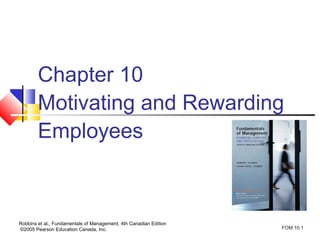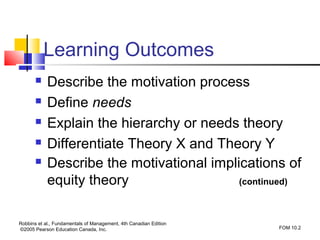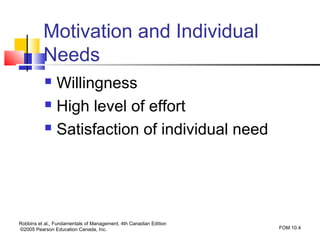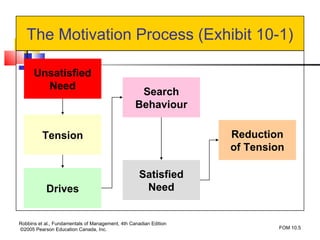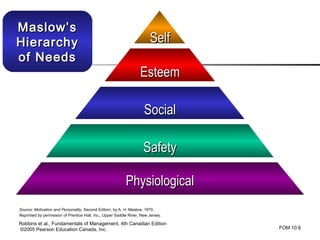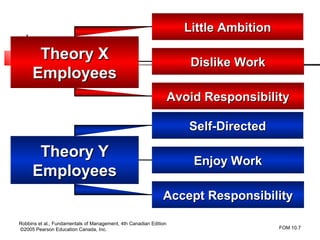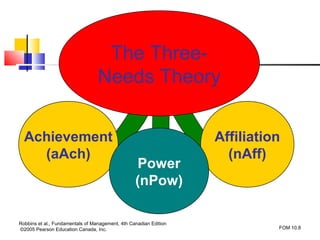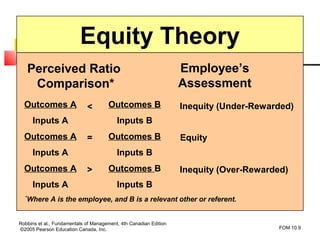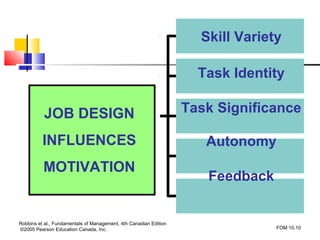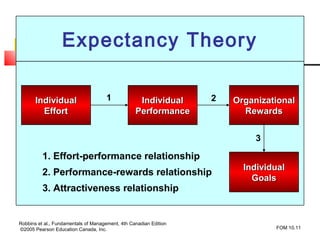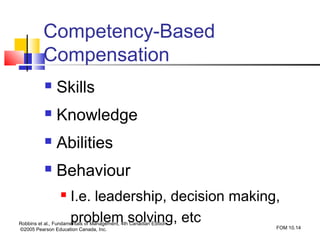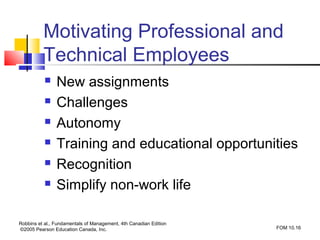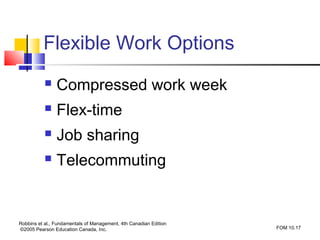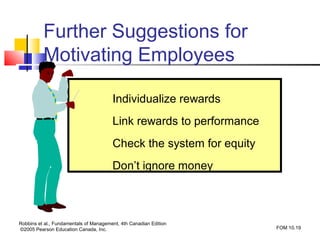Ch10
- 1. Chapter 10 Motivating and Rewarding Employees Robbins et al., Fundamentals of Management, 4th Canadian Edition ┬®2005 Pearson Education Canada, Inc. FOM 10.1
- 2. Learning Outcomes ’ü« Describe the motivation process ’ü« Define needs ’ü« Explain the hierarchy or needs theory ’ü« Differentiate Theory X and Theory Y ’ü« Describe the motivational implications of equity theory (continued) Robbins et al., Fundamentals of Management, 4th Canadian Edition ┬®2005 Pearson Education Canada, Inc. FOM 10.2
- 3. Learning Outcomes (continued) ’ü« Explain the key relationships in expectancy theory ’ü« Describe how managers can design individual jobs to maximize employee performance ’ü« Describe the effect of workforce diversity on motivational practices ’ü« Describe how entrepreneurs motivate their employees Robbins et al., Fundamentals of Management, 4th Canadian Edition ┬®2005 Pearson Education Canada, Inc. FOM 10.3
- 4. Motivation and Individual Needs ’ü« Willingness ’ü« High level of effort ’ü« Satisfaction of individual need Robbins et al., Fundamentals of Management, 4th Canadian Edition ┬®2005 Pearson Education Canada, Inc. FOM 10.4
- 5. The Motivation Process (Exhibit 10-1) Unsatisfied Need Search Behaviour Tension Reduction of Tension Satisfied Drives Need Robbins et al., Fundamentals of Management, 4th Canadian Edition ┬®2005 Pearson Education Canada, Inc. FOM 10.5
- 6. MaslowŌĆÖs Hierarchy Self of Needs Esteem Social Safety Physiological Source: Motivation and Personality, Second Edition, by A. H. Maslow, 1970. Reprinted by permission of Prentice Hall, Inc., Upper Saddle River, New Jersey. Robbins et al., Fundamentals of Management, 4th Canadian Edition ┬®2005 Pearson Education Canada, Inc. FOM 10.6
- 7. Little Ambition Theory X Dislike Work Employees Avoid Responsibility Self-Directed Theory Y Enjoy Work Employees Accept Responsibility Robbins et al., Fundamentals of Management, 4th Canadian Edition ┬®2005 Pearson Education Canada, Inc. FOM 10.7
- 8. The Three- Needs Theory Achievement Affiliation (aAch) (nAff) Power (nPow) Robbins et al., Fundamentals of Management, 4th Canadian Edition ┬®2005 Pearson Education Canada, Inc. FOM 10.8
- 9. Equity Theory Perceived Ratio EmployeeŌĆÖs Comparison* Assessment Outcomes A < Outcomes B Inequity (Under-Rewarded) Inputs A Inputs B Outcomes A = Outcomes B Equity Inputs A Inputs B Outcomes A > Outcomes B Inequity (Over-Rewarded) Inputs A Inputs B * Where A is the employee, and B is a relevant other or referent. Robbins et al., Fundamentals of Management, 4th Canadian Edition ┬®2005 Pearson Education Canada, Inc. FOM 10.9
- 10. Skill Variety Task Identity JOB DESIGN Task Significance INFLUENCES Autonomy MOTIVATION Feedback Robbins et al., Fundamentals of Management, 4th Canadian Edition ┬®2005 Pearson Education Canada, Inc. FOM 10.10
- 11. Expectancy Theory Individual 1 Individual 2 Organizational Effort Performance Rewards 3 1. Effort-performance relationship Individual 2. Performance-rewards relationship Goals 3. Attractiveness relationship Robbins et al., Fundamentals of Management, 4th Canadian Edition ┬®2005 Pearson Education Canada, Inc. FOM 10.11
- 12. Motivating a Diverse Workforce ’ü« Flexibility ’ü« Not everyone sees their job the same way- what motivates me may not motivate you ’ü« Recognize differences ’ü« People are Different ’ü« Accommodate ’ü« Cultural Differences Robbins et al., Fundamentals of Management, 4th Canadian Edition ┬®2005 Pearson Education Canada, Inc. FOM 10.12
- 13. Pay-for-Performance ’ü« Piece rate ’ü« Gainsharing ’ü« Wage-incentive ’ü« Profit-sharing ’ü« Bonuses Robbins et al., Fundamentals of Management, 4th Canadian Edition ┬®2005 Pearson Education Canada, Inc. FOM 10.13
- 14. Competency-Based Compensation ’ü« Skills ’ü« Knowledge ’ü« Abilities ’ü« Behaviour ’ü« I.e. leadership, decision making, problem solving, etc Robbins et al., Fundamentals of Management, 4th Canadian Edition FOM 10.14 ┬®2005 Pearson Education Canada, Inc.
- 15. Motivating Minimum-Wage Employees ’ü« Employee recognition ’ü« Praise ’ü« Empowerment Robbins et al., Fundamentals of Management, 4th Canadian Edition ┬®2005 Pearson Education Canada, Inc. FOM 10.15
- 16. Motivating Professional and Technical Employees ’ü« New assignments ’ü« Challenges ’ü« Autonomy ’ü« Training and educational opportunities ’ü« Recognition ’ü« Simplify non-work life Robbins et al., Fundamentals of Management, 4th Canadian Edition ┬®2005 Pearson Education Canada, Inc. FOM 10.16
- 17. Flexible Work Options ’ü« Compressed work week ’ü« Flex-time ’ü« Job sharing ’ü« Telecommuting Robbins et al., Fundamentals of Management, 4th Canadian Edition ┬®2005 Pearson Education Canada, Inc. FOM 10.17
- 18. Additional Suggestions for Motivating Employees Recognize individuals Match people to jobs Use goals Make goals attainable Robbins et al., Fundamentals of Management, 4th Canadian Edition ┬®2005 Pearson Education Canada, Inc. FOM 10.18
- 19. Further Suggestions for Motivating Employees Individualize rewards Link rewards to performance Check the system for equity DonŌĆÖt ignore money Robbins et al., Fundamentals of Management, 4th Canadian Edition ┬®2005 Pearson Education Canada, Inc. FOM 10.19
- 20. Entrepreneurs and Motivation ’ü« Motivation for entrepreneurs is critical ’ü« Employee empowerment is key motivational tool ’ü« Gradual process ’ü« Delegation ’ü« Job redesign Robbins et al., Fundamentals of Management, 4th Canadian Edition ┬®2005 Pearson Education Canada, Inc. FOM 10.20
Editor's Notes
- #2: 1
- #4: 3
- #5: 4 Before we move into discussing ways to motivate and reward employees, it is important to define and understand motivation. In an organizational setting, motivation is the willingness to exert high levels of effort to reach organizational goals, conditioned by the effortŌĆÖs ability to satisfy some individual need. For our purposes, effort is a measure of intensity. When we speak about someone being motivated, we mean that the person tries hard. But high levels of effort may not lead to favourable job performance unless the effort is channeled in the direction that benefits the organization. Need is some internal state that makes certain outcomes appear attractive. In a work setting, the person may have a need to be promoted. This may motivate the person to exert high levels of job performance in order to meet the need.
- #6: 5 Many people view motivation incorrectly: thinking it is a personal trait that some have and some donŌĆÖt. In reality, motivation results from the interaction between the individual and the situation. WeŌĆÖll examine the overall process of motivation. An unsatisfied need creates tension; this tension drives a person to satisfy the need. A motivated employee works intensely and persistently. However, effort and persistence will not pay off unless they are channeled in a direction that benefits the organization.
- #7: 6 The best-known theory on motivation was developed by Abraham Maslow. According to Maslow, within every human being, a hierarchy of five needs exist. The first three are deficiency needs because they must be satisfied if the individual is to be healthy and secure. The last two are growth needs because they are related to the development and achievement of oneŌĆÖs potential. As each of these needs becomes substantially satisfied, the next higher need becomes dominant. Physiological--food, drink, shelter, sexual satisfaction, and other bodily requirements. Safety--s ecurity and protection from physical and emotional harm. Social--affection , belongingness, acceptance, and friendship. Esteem--internal factors such as self-respect, autonomy, achievement, and external factors such as status, recognition, and attention. Self-actualization--g rowth, achieving oneŌĆÖs potential, and self-fulfillment; the drive to become what one is capable of becoming.
- #8: 7 Douglas McGregor proposed two distinct views about human nature--one a negative view, Theory X, and one a positive view called Theory Y. If a manager sees people as irresponsible and lazy,they will follow Theory X and assume the following: 1. Employees inherently dislike work and will try to avoid it. 2. Since employees dislike work, they must be coerced, controlled, or threatened to achieve goals. 3. Employees avoid responsibilities and seek formal direction, if possible. 4. Most workers place security above all other work-related factors and will display little ambition. However, Theory Y managers see people as responsible and conscientious, and assume the following: 1. Employees can view work as being as natural as rest or play. 2. When committed to their objectives, people will exercise self-direction and self-control 3. The average person can learn to accept, even seek, responsibility. 4. Many workers besides managers have innovative decision-making skills. No hard evidence confirms that either set of assumptions is universally true. It is more likely that the assumptions of Theory X or Theory Y may or may not be appropriate, depending on the situation at hand.
- #9: 9 David McClelland proposed the three-needs theory which asserts that there are three relevant motives or needs that motivate behaviour in the workplace: 1. The need for achievement (nAch) is the need to excel, to achieve in relation to a set of standards, to succeed. 2. The need for power (nPow) is the need to shape and control the behaviour of others. 3. The need for affiliation (nAff) is the desire for interpersonal relationships. He believed that these needs are acquired from the culture of a society. Some people have a compelling drive to succeed, but they strive for personal achievement, not for the rewards of success, per se (nAch) . These high achievers seek situations in which they can take responsibility for solving problems, can receive rapid unambiguous feedback on performance, and can set moderately challenging goals. Persons with a high need for power (nPow) desire to be influential, in charge, and seek competitive, status-oriented situations. Those who have a high need for affiliation (nAff) want to be liked and accepted by others; so, they strive for friendships, cooperation, and high-trust situations.
- #10: 10 Employees compare their job inputs and outcomes with others. There are three possible perceptions: inequity due to being under-rewarded, equity, or inequity due to being over-rewarded. Equity theory proposes that inequity creates tension, and that this tension can cause an employee to seek fairness. The referent with whom employees choose to compare themselves is an important variable. There are three r referents that an employee can use: self, system, and other. Self refers to ratios that are unique to the individual and reflects personal experiences and contacts. System considers organizational pay policies and procedures. Other includes individuals with similar jobs in the same organization and friends, neighbours, or professional associates. Using these comparators, the individuals will compare their pay to others. Employees who perceive an inequity will react in one of five ways: Distort either their own or othersŌĆÖ inputs or outcomes; Behave so as to induce others to change their inputs or outcomes; Behave so as to change their own inputs or outcomes; Choose a different comparison referent; Quit their job. Equity theory recognizes that individuals are concerned not only with the absolute rewards they receive but also with the relationship of those rewards to what other receive.
- #11: 12 Recent work in motivation suggests that the design of a job can motivate. The Job Characteristics Model (JCM) proposes that any job can be described in terms of the following five core job dimensions: 1. Skill variety. Does the job require workers to use different skills and abilities? 2. Task identity. Does the job require workers to complete identifiable pieces of work? 3. Task significance. Does the job have a significant impact on the lives or work of others? 4. Autonomy. Does the job allow employees substantial freedom, discretion, and independence? 5. Feedback. Does the job allow workers to obtain direct, clear performance information?
- #12: 16 Expectancy theory states that an individual tends to act in a certain way on the basis of the expectation that the act will be followed by an outcome that is attractive to the individual. For example, an employee will be motivated to produce more when he or she believes that the effort will lead to a good performance appraisal; that a good appraisal will lead to organizational rewards; and that the rewards will satisfy the employeeŌĆÖs personal goals. This theory focuses on three relationships. 1. The effort-performance relationship is the probability perceived by the individual that exerting a given amount of effort will lead to performance. 2. The performance-reward relationship is the degree to which an individual believes that performing at a particular level will lead to the attainment of a desired outcome. 3. Attractiveness is the importance the individual places on the potential reward that can be achieved on the job.
- #13: 18 Managers today are faced with motivating a very different workforce than not too many years ago. So, what can a manager do? First, it is important for managers to think in terms of flexibility. Not everyone views their job in the same way and therefore what motivates one person may not motivate another. Likewise, it is important to recognize the differences among people. Lastly, the manager must be able and willing to accommodate cultural differences. For example, the need for achievement is a North American concept and may not function in other cultures.
- #14: 19 Organizations are increasingly using different types of pay-for-performance compensation schemes in an effort to increase the motivation of employees. But does this work? Certainly performance-based compensation is most compatible with expectancy theory. If employees perceive a strong relationship between their performance and rewards, their motivation will be maximized.
- #15: 20 Another variation of the pay-for-performance concept is competency-based compensation. This is gaining quite wide reception as it pays and rewards people based on their skills, knowledge, abilities, and behaviours. Some of the competencies could include skills and behaviours such as leadership, problem-solving, or decision-making. Pay increases as peopleŌĆÖs competencies grow and expand.
- #16: 21 Given the shift in Canada from a resource-based economy to a service economy, many well-paid jobs have been replaced by part-time and minimum wage jobs. One of the tremendous challenges for managers is to motivate people who are earning base wages. One of the ways that many fast-food restaurants, such as McDonaldŌĆÖs or WendyŌĆÖs, use is an employee recognition program such as ŌĆ£employee of the weekŌĆØ or ŌĆ£employee of the month.ŌĆØ A frequent component of this type of recognition program is displaying the personŌĆÖs picture in a prominent place. What is important for the manager to remember is that not all people are motivated by money. Frequently, people like to have a pat on the back and praise for a job well-done. But it has to be sincere and used appropriately. By using the JCM model, jobs can be redesigned to empower front-line employees to enhance motivation. For example, many hotels are re-designing work so that people who are in direct contact with the hotel guest can take care of customer complaints or requests that previously had been referred to a supervisor.
- #17: 22 Professional and technical employees usually have a strong and long-term commitment to their field or expertise. Think about the new generation of computer specialists. Money and promotions tend to be low on their priority list as they tend to be well-paid and usually enjoy what they do. Therefore, more money or promotions will not necessarily increase motivation. So, what will? Managers can ensure that these employees have new assignments and challenging projects. Also, it is important to give them autonomy in getting the job done. Professional and technical employees like to keep current in their field, so give them additional training and educational opportunities where they can also network with their peers. And managers should reward them with recognition by calling on them to demonstrate their expertise. One of the more creative ways to motivate these employees is to provide help to simplify their non-work life. Many work long hours and may not have sufficient time for routine household chores. For example, Zero Knowledge Systems in Montreal provides laundry services at work where employees can get their clothes laundered and folded.
- #18: 23 Many employees would be more motivated to perform well with flexible work options. This can make complex lives much easier. For example, a parent may need or want to be at home when the children come home from school. There a number of options that can be considered. Compressed work week is taking the normal work week of 5 days and compressing it into something less. Examples include a 40 hour week compressed into 4 days of 10 hours each day. Or as in the nursing profession where nurses may work a 12-hour day for each of 3 days. Flex-time is a scheduling system that allows employees to decide, within certain parameters, when to go to work. While the employee will have to work a certain number of hours each day, the person can choose when to arrive and when to leave. For example, a business that is open from 7 a.m. to 7 p.m. may decide that the core business hours are 9 a.m.-2 p.m. and that everyone has to be there during that time. However, a person could choose to come in at 7 a.m. or 9 a.m. and leave 7 hours later. One of the drawbacks to flextime is that not all jobs or all businesses can function with people picking when to arrive/leave. Job sharing is where 2 or more people share 1 job. This happens fairly frequently with parents being able to work regular hours yet have time for the children. With the advances of computer technology, more and more people can do work from their home on a computer linked with their office. This is referred to as telecommuting. For employees, big advantages are the decrease in time and stress of commuting and the increased flexibility in coping with family demands. But again, not all work can be structured for telecommuting. Also, managers need to ensure that the person is connected so that the person doesnŌĆÖt miss out on subtleties that occur in an office environment.
- #19: 24 Other ways that a manager can motivate employees is to recognize them as individuals and match people to the jobs. Likewise, establishing goals that are attainable can go a long way to motivate employees to achieve great performance.
- #20: 25 As mentioned in the sections about minimum wage and professional employees, one way to motivate is to individualize rewards and ensure that the rewards are linked to the performance. Too often people are rewarded whether the performance is good or not. It is also important to check your internal pay system for equity. Again, it doesnŌĆÖt help motivate people if there is a perception of unfairness in the reward systems. And last, but certainly not least, do not ignore money as a motivator. If the pay isnŌĆÖt as it should be, no matter how much effort the manager may put in recognizing and praising employees, people may not be motivated due to low pay levels.
- #21: Having motivated employees is an important goal for any entrepreneur. For example, Sapient Corporation co-founders Jerry Greenberg and J. Stuart Moore recognized that employee motivation was critically important to their companyŌĆÖs ultimate success. They designed their organization so that individual employees are part of an industry-specific team that works on an entire project. Employee employer is an important motivational approach as successful entrepreneurial ventures must be quick and nimble, ready to pursue opportunities and go off in new directions. Empowered employees can provide that flexibility and speed. However, for many entrepreneurs it is a gradual process, includes delegation and eventually results in redesigning the job so that employees have discretion over the way they do their work.
